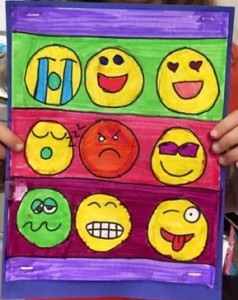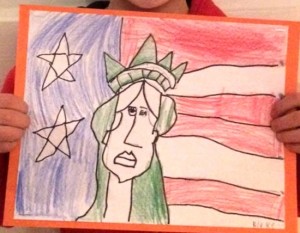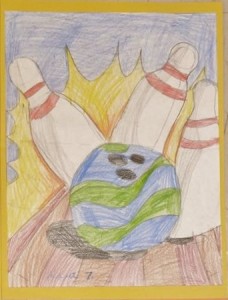Visual Kids Draw to Learn
Here on my blog and in my book, I’m focused on sharing ways to help our right-brain visual kids understand who they are and excel in a left-brain world. As the founder and CEO of Young Rembrandts, I’ve seen first hand how learning to draw gives visual kids skills that impact every part of their learning. It improves their handwriting, helps them organize their thinking, prepares them for visual note taking, which is huge for visual kids in the classroom. Drawing also develops patience and focus and joy of doing art.
Take a look at a couple of the lessons our 6 and 7 year old students did recently:
 Emoticons
Emoticons
This was a new lesson for us this winter and very popular with the kids. And while it may seem deceptively simple, there was a lot of planning, measuring and drawing happening, before we got to the simple stylized faces. Once the paper was divided and the correct sized circles carefully placed, it was time to add our faces. This was a great exercise in learning to convey emotions and mood with a few carefully drawn shapes and features. Visual kids are very attuned to faces and emotions, so this drawing exercise is perfect for them, giving language to what they see.

This was six-year-old Blake’s first Young Rembrandts class ever. And wow what a challenging drawing, with impressive results! The kids learned about a famous landmark, while drawing a portrait. There was lots of observation, instruction and planning needed to draw Lady Liberty. After mastering her detailed face, they drew a simplified American flag design. They learned to draw stars, planned spaces and after all that drawing, they mastered the black outline and focused colored pencil technique. The art they did was very impressive, but it was so much more. Visual kids learn best when actively involved in their learning. Drawing a famous landmark while learning about it is perfect for them.

Once a month in Young Rembrandts, we draw a still life, because learning to draw realistically requires heightened observation skills and mastery of technique. Once the kids draw the basic composition, they plan shadows and highlights throughout. The added dimension helps the piece jump off the page with realism. Our kids work hard, learning color pencil technique, developing concentration skills and the ability to stay on task, which is especially helpful for our easily distracted visual kids. But when they learn through something they love to do, like art, it doesn’t feel like learning. They just enjoy their time coloring. But we know how much more happened.
Young Rembrandts has franchisees all across the US and Canada. We even have kids drawing in Jordan and Saudi Arabia! Week after week an army of Young Rembrandts’ instructors, trained in the Young Rembrandts teaching method, use our curriculum to teach drawing classes to preschool and elementary age kids. And week after week they gain art and learning skills.










